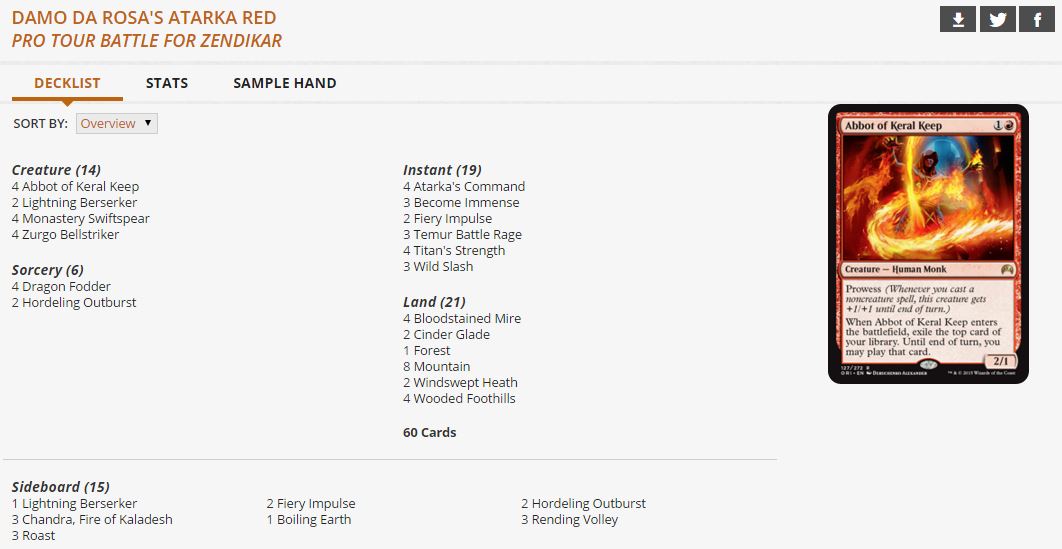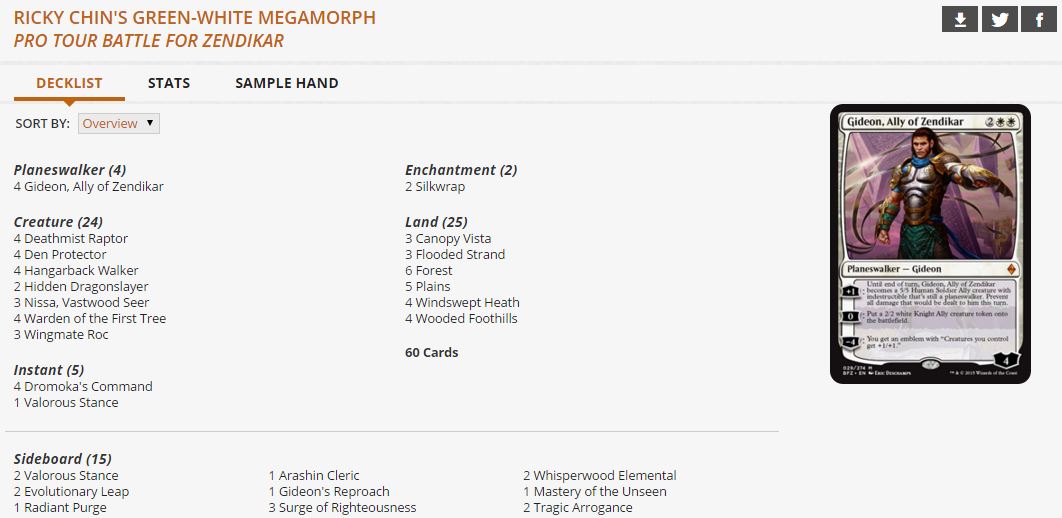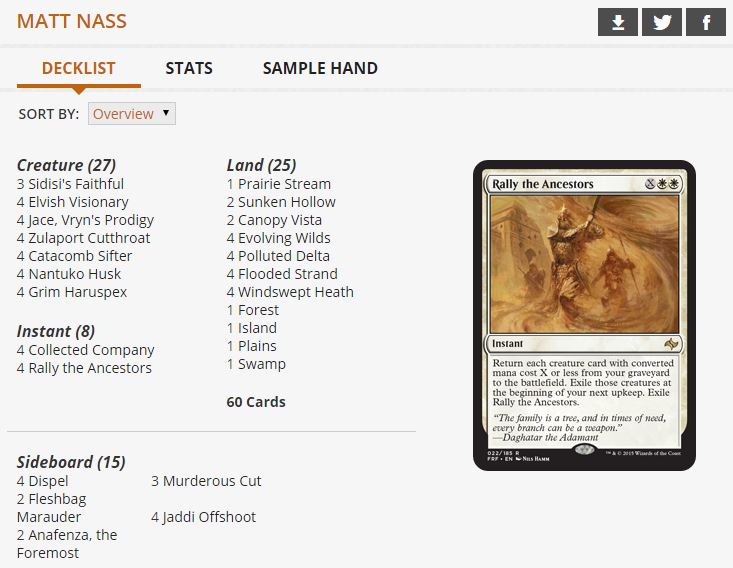Welcome back to Magic Gatherings!
Last column I introduced the Standard format. I wrote a bit about the requirements and spotlighted the new decks from the first major tournament that used Battle for Zendikar cards. The major question at the end of the column was whether Pro Tour Battle for Zendikar—which happened this past weekend in exotic Milwaukee, Wisconsin—would shake up the best decks from the recent Star City Games Open Series tournaments in Indianapolis and Atlanta.
This week I’ll talk a bit about the results of the Pro Tour, a bit about the current state of Standard, and a bit about how to get into the format yourself. Let’s get to it!
Pro Tour Results
So: the Pro Tour. 367 planeswalkers gathered in Milwaukee this weekend to duel for supremacy over sixteen rounds of Standard constructed and Battle for Zendikar draft. Pro Tours, which now occur like clockwork two weeks after each new set releases, usually set the tone for the constructed format they feature and inspire the decks people play for at least the next few months. As I’ve mentioned previously, Pro Tours tend to encourage innovation: the prize purse is substantial (for a Magic tournament; Magic prizes still lag behind prizes for e-Sports and other gaming competitions), so there is lots of advantage to be gained from finding the best possible deck, or even playing something other pros don’t expect. For us fans, it’s natural to want to play a deck you see do well in the hands of a pro you admire.
To look at the Top 8, this Pro Tour would seem disappointing on that front. Going into the weekend, the big three decks in Standard were Atarka Red, Green-White Megamorph, and Jeskai Black. Coming out of the Pro Tour, the big decks look to be…Atarka Red, Green-White Megamorph, and Jeskai Black. Take a look at a few of the decklists for the Pro Tour’s Top 8:
In seventh place, Paulo Vitor Damo da Rosa (in his tenth Pro Tour Top 8!), with Atarka Red:
In sixth place, Pro Tour first-timer Ricky Chin, with Green-White Megamorph:
In third place, all-time great Jon Finkel, with Jeskai Black:
And winning the whole shebang, Kazuyuki Takimura of Japan, with Abzan:
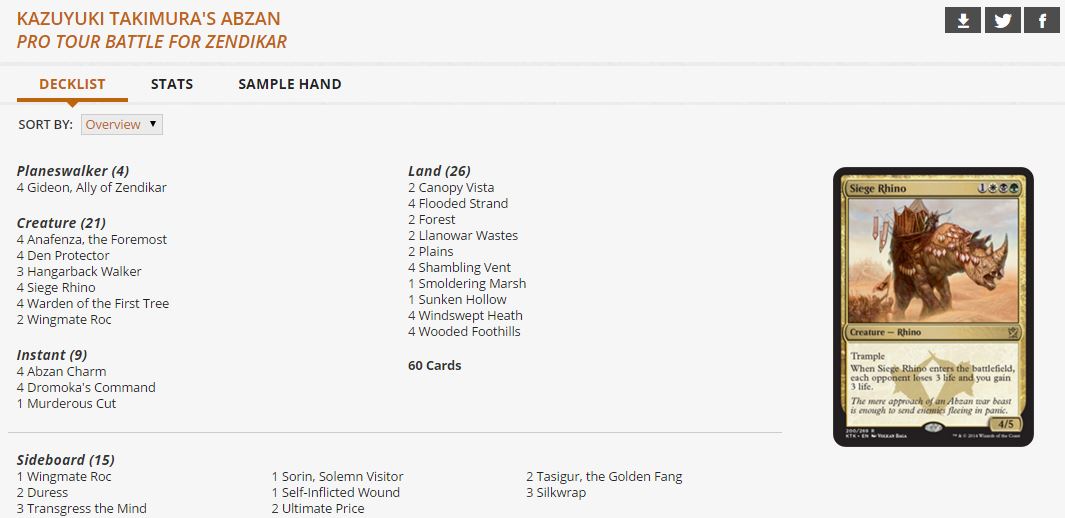 [Formatting note: These are just screengrabs from Wizards.com, as I’m currently searching for a more attractive way to display decklists than the plugin I’m using right now. In the meantime, if you would like an interactive list, you can find the deck on the Wizards.com coverage page here, or on this list of Pro Tour decklists at mtggoldfish.com.]
[Formatting note: These are just screengrabs from Wizards.com, as I’m currently searching for a more attractive way to display decklists than the plugin I’m using right now. In the meantime, if you would like an interactive list, you can find the deck on the Wizards.com coverage page here, or on this list of Pro Tour decklists at mtggoldfish.com.]
These decks are all more or less tuned versions of decks that had already debuted on the Star City circuit in the two weeks leading up to the Pro Tour. They’re broadly representative of the Pro Tour field as a whole: most players concluded that the best decks were Atarka Red, Jeskai, and Green-White, and played some version of those decks, tuned to beat the other top decks. Those three, in that order, were the most commonly played decks.
In the days since the Pro Tour, a lot people have commented on the relatively minimal impact Battle for Zendikar had on the Standard format. Aside from lands, the most played BFZ card was, by far, [mtg_card]Gideon, Ally of Zendikar[/mtg_card]. The next most played were [mtg_card]Radiant Flames[/mtg_card] and [mtg_card]Dispel[/mtg_card], both mostly sideboard cards, and the latter a reprint. More linear strategies like Allies, Devoid, and Eldrazi ramp never really showed up.
“Aside from lands” is a significant caveat, though, and helps to explain the problem. As I covered last week, the fetchland-battle land interaction makes it very easy to build a four- or five-color manabase. That, in turn, makes it easy to take advantage of the powerful gold cards from Khans of Tarkir. From that perspective, Battle for Zendikar has had a big impact on Standard—namely, making it even easier to play great cards that aren’t in BFZ.
The Best of the Rest
The innovative decks in this Pro Tour tended to fall outside the top 8. That doesn’t mean they were bad decks, of course—the split format of the Pro Tour (six rounds of booster draft and ten rounds of constructed) means that successful decks can be held back by weak limited records. Going down the list of winning Standard decks, there are some cool ones worth noting:
GW Aggro—Bristol, UK native Autumn Burchett had the best overall constructed record (at 9-1) with this twist on Green-White Megamorph. Burchett eschewed Battle for Zendikar standout newcoming [mtg_card]Gideon, Ally of Zendikar[/mtg_card] in favor of [mtg_card]Archangel of Tithes[/mtg_card], a powerful card from Magic Origins which hasn’t found a home in Standard yet. Archangel does a lot of things for this deck, though: it blocks flyers, a traditional weakness of green-white, and its taxing effect makes it harder for aggressive decks like Atarka Red decks to have enough mana to attack and combo out with [mtg_card]Become Immense[/mtg_card] + [mtg_card]Temur Battle Rage[/mtg_card].
 The deck also uses [mtg_card]Knight of the White Orchid[/mtg_card], doing its best [mtg_card]Elvish Mystic[/mtg_card] impersonation, to steal initiative. On the draw, a turn-three Knight can put you straight to four lands for a quick [mtg_card]Silkwrap[/mtg_card], then set up a raided [mtg_card]Wingmate Roc[/mtg_card] the next turn.
The deck also uses [mtg_card]Knight of the White Orchid[/mtg_card], doing its best [mtg_card]Elvish Mystic[/mtg_card] impersonation, to steal initiative. On the draw, a turn-three Knight can put you straight to four lands for a quick [mtg_card]Silkwrap[/mtg_card], then set up a raided [mtg_card]Wingmate Roc[/mtg_card] the next turn.
Bant Tokens—Top prize for the hands-down coolest deck goes to Sam Black, who built an amazing Bant (green-white-blue) Tokens deck. Black is known for building unusual decks that maximize overlooked cards, and this deck, assembled the actual day before the Pro Tour started, is no different. It’s a base-white deck that leverages [mtg_card]Retreat to Emeria[/mtg_card] to assemble token armies and then pump them up for the win:
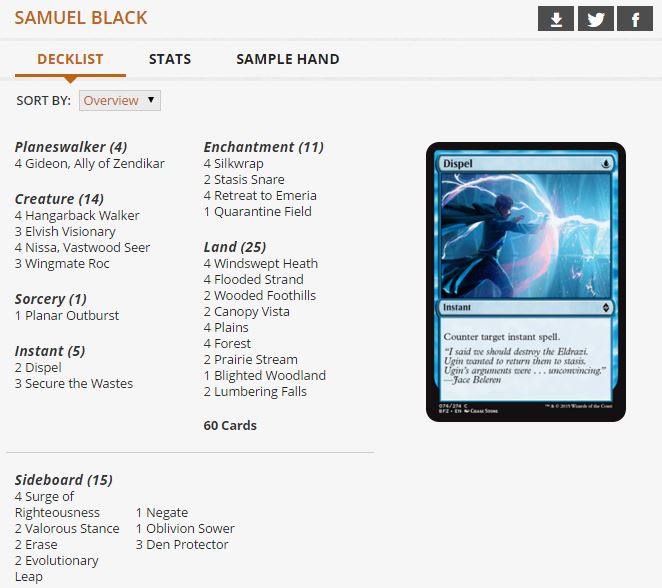 It looks like a bit of a hodgepodge on paper, but the deck has a lot of sweet plays. My favorite is end-of-turn [mtg_card]Secure the Wastes[/mtg_card] into Retreat or Gideon, which can be double-digit damage out of nowhere pretty easily. You can see a video of former U.S. National Champion Paul Cheon playing the deck here.
It looks like a bit of a hodgepodge on paper, but the deck has a lot of sweet plays. My favorite is end-of-turn [mtg_card]Secure the Wastes[/mtg_card] into Retreat or Gideon, which can be double-digit damage out of nowhere pretty easily. You can see a video of former U.S. National Champion Paul Cheon playing the deck here.
UB Aristocrats—Several Aristocrats-style decks showed up this weekend. Of these, this blue-black version piloted by Christian Calcano (tuned by notorious raredrafter Pascal Maynard) got the most attention:
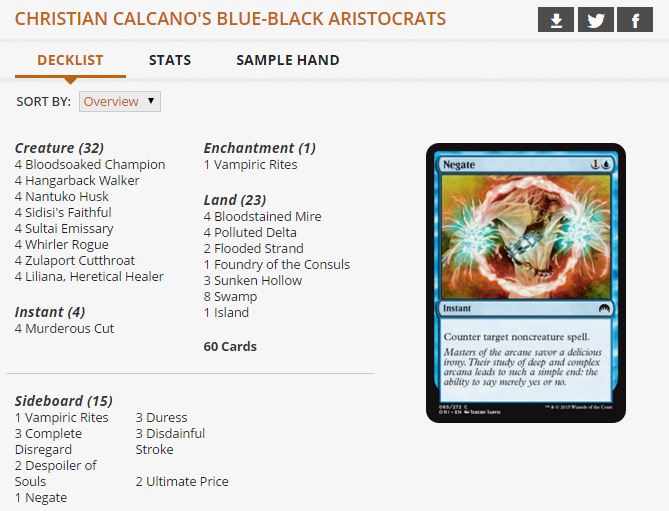 Aristocrats-style decks, named for this Pro-Tour winning deck (designed by Sam Black and piloted by Tom Martell) focus on sacrificing their own creatures for value, typically using cards like [mtg_card]Zulaport Cutthroat[/mtg_card] (or [mtg_card]Blood Artist[/mtg_card], in the original version) to drain out opponents. This version leverages [mtg_card]Whirler Rogue[/mtg_card], who not only brings two ready-to-bin Thopter tokens along with her, but can make [mtg_card]Nantuko Husk[/mtg_card] unblockable. It also plays [mtg_card]Sidisi’s Faithful[/mtg_card], which combines particularly well with [mtg_card]Liliana, Heretical Healer[/mtg_card]. The deck is tricky to play perfectly, but it’s a deck unlike any other.
Aristocrats-style decks, named for this Pro-Tour winning deck (designed by Sam Black and piloted by Tom Martell) focus on sacrificing their own creatures for value, typically using cards like [mtg_card]Zulaport Cutthroat[/mtg_card] (or [mtg_card]Blood Artist[/mtg_card], in the original version) to drain out opponents. This version leverages [mtg_card]Whirler Rogue[/mtg_card], who not only brings two ready-to-bin Thopter tokens along with her, but can make [mtg_card]Nantuko Husk[/mtg_card] unblockable. It also plays [mtg_card]Sidisi’s Faithful[/mtg_card], which combines particularly well with [mtg_card]Liliana, Heretical Healer[/mtg_card]. The deck is tricky to play perfectly, but it’s a deck unlike any other.
The Pro Tour also saw a more traditional Green-Black Aristocrats build in the hands of Gabriel Nassif. This version uses [mtg_card]Smothering Abomination[/mtg_card] and [mtg_card]Grim Haruspex[/mtg_card] to draw tons of cards. It’s less expensive, but I worry that it doesn’t have anything truly powerful to draw into.
Finally, there’s this wild four-color Rally the Ancestors deck that was played by Matt Nass:
This deck takes the combo finish a little further than the others. A [mtg_card]Rally the Ancestors[/mtg_card] for X = 3 will return every creature in your graveyard, which hopefully includes at least one [mtg_card]Zulaport Cutthroat[/mtg_card], one [mtg_card]Nantuko Husk[/mtg_card], and a ton of incidental value from other creatures. [mtg_card]Collected Company[/mtg_card] helps hit a critical mass of creatures, and Jace helps smooth out draws and flash back copies of Rally you may have had to discard earlier. Jace seems very important, but aside from him, this deck isn’t too expensive to build. If it seems like fun, you can check out this video of Luis Scott-Vargas playing the deck to get a better feel for it.
Again, you can see all the decklists that posted winning records in this handy, interactive list here.
Gold Standard
As you look over that list, I’m sure you’ll notice something else: the average prices of Standard decks are very, very high right now. I’ve only briefly touched on the financial aspects of Magic and I’d never claim to be a #mtgfinance expert. But with some decks currently fetching prices of $700 and up, it seems important to say something.
There are four major culprits behind the high prices in Standard right now: Gideon, Hangarback Walker, Jace, and the Khans of Tarkir fetchlands.
 [mtg_card]Gideon, Ally of Zendikar[/mtg_card], is the most impactful Standard card from a brand-new set. He goes in lots of decks, so lots of players can use him; meanwhile, supply of Battle for Zendikar will never be lower than it is right now, so there’s not many copies to offset that demand. He’s tough to replace, but if you can live without him, his price should slowly come back to earth over the next few months, to settle in the $25 range.
[mtg_card]Gideon, Ally of Zendikar[/mtg_card], is the most impactful Standard card from a brand-new set. He goes in lots of decks, so lots of players can use him; meanwhile, supply of Battle for Zendikar will never be lower than it is right now, so there’s not many copies to offset that demand. He’s tough to replace, but if you can live without him, his price should slowly come back to earth over the next few months, to settle in the $25 range.
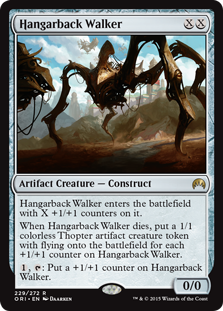 [mtg_card]Hangarback Walker[/mtg_card] is a surprise card from Magic Origins. As an artifact creature, it can go in a lot of different decks, and surprisingly, what it offers is something that lots of decks want. [mtg_card]Hangarback Walker[/mtg_card] was included in the Battle for Zendikar event deck, so everyone who buys one is guaranteed a copy. That’s slowly bringing the price down into the $15 range, and I suspect it will settle a little lower.
[mtg_card]Hangarback Walker[/mtg_card] is a surprise card from Magic Origins. As an artifact creature, it can go in a lot of different decks, and surprisingly, what it offers is something that lots of decks want. [mtg_card]Hangarback Walker[/mtg_card] was included in the Battle for Zendikar event deck, so everyone who buys one is guaranteed a copy. That’s slowly bringing the price down into the $15 range, and I suspect it will settle a little lower.
 [mtg_card]Jace, Vryn’s Prodigy[/mtg_card] is another surprise from Origins, one that’s currently seeing play in almost every constructed format there is. Demand is high, and unlike [mtg_card]Hangarback Walker[/mtg_card], the supply is more or less limited to the Origins that’s been opened so far. (Players can open new Origins packs, of course, but Jace is a mythic, and he probably won’t get reprinted in a supplementary product.) Like Gideon and Hangardback, Jace can go in a lot of decks, and he’s relatively difficult to replace—there’s not an analogous card like [mtg_card]Merfolk Looter[/mtg_card], which would fill at least some of the function.
[mtg_card]Jace, Vryn’s Prodigy[/mtg_card] is another surprise from Origins, one that’s currently seeing play in almost every constructed format there is. Demand is high, and unlike [mtg_card]Hangarback Walker[/mtg_card], the supply is more or less limited to the Origins that’s been opened so far. (Players can open new Origins packs, of course, but Jace is a mythic, and he probably won’t get reprinted in a supplementary product.) Like Gideon and Hangardback, Jace can go in a lot of decks, and he’s relatively difficult to replace—there’s not an analogous card like [mtg_card]Merfolk Looter[/mtg_card], which would fill at least some of the function.
Finally, the Khans fetch lands have risen up into the $20 range over the last few months. This is a bit of a surprise, since the shocklands from Return to Ravnica (which are also Modern staples) settled around $10 and have only slowly risen, even though that set is now out of print. The silver lining here is that these fetch lands are playable in older, non-rotating formats; they should maintain their value even after Khans rotates out this coming spring. They’re also a bit more replaceable than the other cards—fixing your mana is really good, don’t get me wrong, but if you’re playing a mono-colored or two-color deck, you can make do with [mtg_card]Evolving Wilds[/mtg_card] or the Khans gainlands.
Aside from those, Standard cards are pricey, but not outrageous. Gabriel Nassif’s BG Aristocrats deck, for example, has a sticker price of around $345. That is a lot of money. $210 of that is fetch lands, though, and another $58 is [mtg_card]Hangarback Walker[/mtg_card]s. Replace [mtg_card]Hangarback Walker[/mtg_card] with [mtg_card]Sultai Emissary[/mtg_card] and run [mtg_card]Llanowar Wastes[/mtg_card] and [mtg_card]Evolving Wilds[/mtg_card] over fetches and battle lands, and the deck cost falls to a much more reasonable $75. In fact, if you eschew [mtg_card]Collected Company[/mtg_card], you can build the rest of the deck out from a Battle for Zendikar event deck without too much trouble.
Standard on a Budget
If you’re thinking of getting into Standard, there’s no doubt that now is a bit of an awkward time to do it, especially if you’re a newer or more casual player, who might not already have last year’s fetchlands and rares. So what’s the best way to approach constructed Magic over the next few months?
Play Casually
One option is to sit the season out entirely. The metagame should shift significantly after Khans rotates and fetch-battle manabases are no more; at the very least, it will take the edge off of manabase costs. (Battle lands are pretty inexpensive right now, since most decks only need a few of each.) Oath of the Gatewatch, the second expansion in the Battle for Zendikar block, will be out in three months, and that might bring some extra punch for decks built around BFZ mechanics, too—one good Ally could be all it takes to put that deck over the top.
In the meantime, if you’re playing at home with friends, you are free to proxy whatever cards you’d like to try. You can make your own rules, your own formats, focus on Commander, etc. There’s always lots of ways to play Magic, which is part of what makes it a good game.
Let’s say you’d prefer to play at your friendly local gaming store. After all, you probably have a lot of friends there, too. (So many friends! Way to go, reader.) Even for small tournaments like Friday Night Magic, you’ll need physical copies of all the cards in your deck. What’s the best way to play without breaking the bank?
 Find analogous cards—One way to save is to find less-expensive-but-analogous versions of cards in your favorite deck. In Gabriel Nassif’s deck, for example, you can swap out [mtg_card]Hangarback Walker[/mtg_card] for [mtg_card]Sultai Emissary[/mtg_card]. You lose some flexibility, but as a two-drop creature that leaves behind another creature when it dies, [mtg_card]Sultai Emissary[/mtg_card] does most of what you’re looking for.
Find analogous cards—One way to save is to find less-expensive-but-analogous versions of cards in your favorite deck. In Gabriel Nassif’s deck, for example, you can swap out [mtg_card]Hangarback Walker[/mtg_card] for [mtg_card]Sultai Emissary[/mtg_card]. You lose some flexibility, but as a two-drop creature that leaves behind another creature when it dies, [mtg_card]Sultai Emissary[/mtg_card] does most of what you’re looking for.
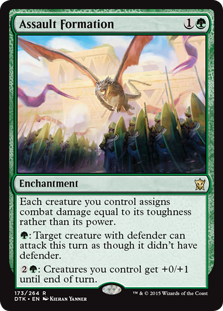 Find undervalued cards—Lots of cards get overshadowed or overlooked for one reason or another—maybe they’re slightly worse than another option, or they match up against popular cards in a way that’s less than ideal. Those are important considerations if you’re building a deck to win ten or fifteen rounds against great players in a major tournament, but they’re less of an issue for bringing an interesting card to a four-round Friday Night Magic. Cards like [mtg_card]Anafenza, Kin-Tree Spirit[/mtg_card] or [mtg_card]Arashin Foremost[/mtg_card] can win games; cards like [mtg_card]Alesha, Who Smiles at Death[/mtg_card] or [mtg_card]Assault Formation[/mtg_card] can inspire whole decks. And those are just the A’s!
Find undervalued cards—Lots of cards get overshadowed or overlooked for one reason or another—maybe they’re slightly worse than another option, or they match up against popular cards in a way that’s less than ideal. Those are important considerations if you’re building a deck to win ten or fifteen rounds against great players in a major tournament, but they’re less of an issue for bringing an interesting card to a four-round Friday Night Magic. Cards like [mtg_card]Anafenza, Kin-Tree Spirit[/mtg_card] or [mtg_card]Arashin Foremost[/mtg_card] can win games; cards like [mtg_card]Alesha, Who Smiles at Death[/mtg_card] or [mtg_card]Assault Formation[/mtg_card] can inspire whole decks. And those are just the A’s!
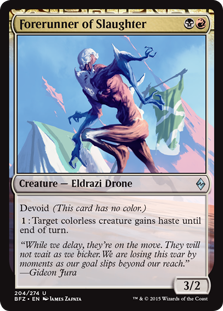 Focus on aggression—One strategy for saving is to build an aggressive deck. There are a few reasons for this. First, the best aggressive cards tend to be inexpensive—often, they’re commons or uncommons. Take [mtg_card]Forerunner of Slaughter[/mtg_card], for example. You get a great power-to-mana-cost ratio and an aggressive ability to boot. Cards like [mtg_card]Atarka’s Command[/mtg_card] and [mtg_card]Abbot of Keral Keep[/mtg_card] are rare exceptions (and those particular cards see play in Modern, to boot). Aggressive decks also tend to be mono- or two-colored, so you save on expensive lands.
Focus on aggression—One strategy for saving is to build an aggressive deck. There are a few reasons for this. First, the best aggressive cards tend to be inexpensive—often, they’re commons or uncommons. Take [mtg_card]Forerunner of Slaughter[/mtg_card], for example. You get a great power-to-mana-cost ratio and an aggressive ability to boot. Cards like [mtg_card]Atarka’s Command[/mtg_card] and [mtg_card]Abbot of Keral Keep[/mtg_card] are rare exceptions (and those particular cards see play in Modern, to boot). Aggressive decks also tend to be mono- or two-colored, so you save on expensive lands.
The other bonus is strategic: if your opponent has a more expensive or more powerful deck than yours, the best way to minimize their advantage is to end the game as quickly as possible. If their average card is better than your average card, a faster game means that they see fewer of their cards. They get less net advantage and are less likely, on the whole, to see their very best cards.
Borrow cards—Remember all those friends you have? They play Magic too (or, if they don’t, they should). They’re likely to have good cards they’re not using, just like you do. If you agree to play different decks, you can share out cards with one another, and everyone will be a little closer to their ideal deck. Pros do this all the time—no one owns four copies of every Magic card. Just be sure to keep track of who owns what, and be careful with cards that aren’t yours!
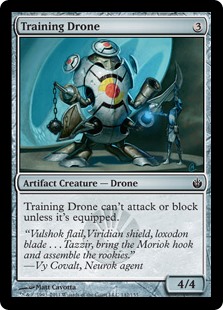 Pick a deck and practice with it—One way to focus your resources is to pick one deck that you’re fairly certain you want to play, and get to know it inside and out. Whereas pros often change decks from week to week based on tournament metagame trends, this is less common for the average player. Luckily, you can gain advantages from knowing your deck well and having a cohesive plan for popular decks you expect to face. Knowing just how to play a match and what’s important is worth a lot.
Pick a deck and practice with it—One way to focus your resources is to pick one deck that you’re fairly certain you want to play, and get to know it inside and out. Whereas pros often change decks from week to week based on tournament metagame trends, this is less common for the average player. Luckily, you can gain advantages from knowing your deck well and having a cohesive plan for popular decks you expect to face. Knowing just how to play a match and what’s important is worth a lot.
Sometimes you’ll get excited about a deck just by reading decklists, but if you’re on the fence about what to build, Metadeck is a great resource. You can enter decklists and print reminder cards that proxy up to twelve decks at once. In my opinion, this sort of preparation is severely underrated—every time I have ever been happy with a deck I played for any given stretch of time, it’s because I tried it out this way first.
Standard Procedure
Hopefully this look at Standard has given you some ideas about what you might like to play! Standard is great, and I encourage you to try it if you haven’t. At the same time, as you might already have concluded, moments like this (when cards are pricey) are good moments to look at what you want to get out of the game, to make sure you’re enjoying Magic just the way you want to.
I’ve gotten some comments from readers with deck ideas, and I’ll take a look at those next time.

